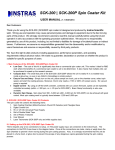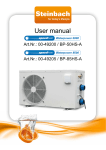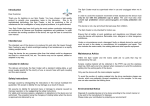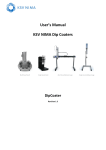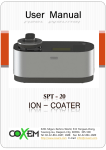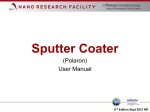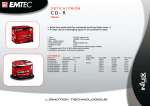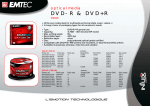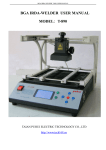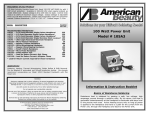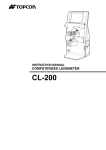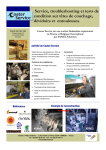Download SCK-100HS Spin Coater Kit
Transcript
SCK-100HS Spin Coater Kit USER MANUAL v1.2 4/12/2012 Dear Customers: Thank you for using the SCK-100HS spin coater kit designed and produced by Instras Scientific LLC. Wrong use and operation may cause personal injuries and damage to equipment due to the fast moving parts of the product. We strongly recommend customers read this manual carefully before using the SCK-100HS kit and operate it in strict accordance with the operating procedure outlined below. We assume no responsibility generated by use of this product, including, but not limited to liabilities for damage of incidental losses or indirect losses. Furthermore, we assume no responsibilities generated from the disassemble and modification by users themselves and assume no responsibility caused by third party products. We have the right to alter products including appearance, performance parameters and operating requirement without advance notice. We make no guarantee, declaration or promise on whether the product is suitable for specific purpose of users. I. Main Features of the SCK-100HS Spin Coater Kit ● Low Cost - The cost of this kit is significantly less than a commercial spin coater unit. This makes it ideal for R&D work where the benefits of a commercial spin coater is yet to be determined. It also means that multiple units can be purchased to speed up the research process. ● Compact Size - The small foot print of the SCK-100HS means that it requires very little space. For example, the unit can be setup in a crowded hood, inside a glove box, or even in an Aldrich’s AtmosBag or similar product. ● Easy to Use - Simply turn on the unit, place sample on chuck, put on the chamber cover, select spin speed, and start the coating process. ● Simple/Modular Design - The unit only needs a 110V/220V A/C power source and no vacuum pump. Also, as a result of the modular design, replacement parts can be purchased separately. For example, if the spin chamber becomes too dirty, or damaged, then it can be replaced at little cost. ● Dynamic Spin Range - Spin rates from 1,500 - 10,000 rpm can be achieved with good control. Most spin coating work is typically done between 1,200 and 5,000 rpm. II. SCK-100HS Spin Coater Kit Contents The spin coater kit contains the following items: ● Spin Coating Chamber (Motor/Aluminum Chuck/CD Cakebox) and Plexiglas Base ● Control Unit ● 9V DC Universal Power Supply ● Roll of Double Sided Tape ● Set of Plastic Tweezers ● User Manual III. Setting up the SCK-100HS Spin Coater Kit The SCK-100HS requires only a few connections to setup. (1) The 9V DC input from the power supply, (2) connection to the motor/chuck, and (3) connection to the K1 RPM meter. The K1 RPM meter is connected to the white/red/black signal cable as shown in the diagram below. Please note, the spin coater will still work without the K1 RPM meter connected. The meter is only used to provide an estimate (within +60 rpm) of the current speed. Once all the connections are made, clamp or weigh down the Spin Chamber to prevent it from moving during the spin coating process. Also, it is strongly recommend that the unit be placed in a fume hood, or glove box to prevent the escape of any dangerous vapors generated during the spin coating process in an area where they can be inhaled. IV. Using the SCK-100HS Spin Coater Kit Warning: NEVER START THE MOTOR/CHUCK WITHOUT THE SPIN CHAMBER COVER IN PLACE Before powering on the unit, make sure the “Speed Control Knob” is at the zero position and the “Pause Switch” is off. When the unit is powered on, there is a short musical chime followed by a series of 3 beeps, 3 sec pause, then one final beep. This indicates the unit is ready for use. If the musical chime is followed by a continuous series of beeps, it means the “Speed Control Knob” is not at zero. If the musical chime is followed by no beeps it means the “Pause Switch” is not off. If there is no chime or beeps, it means the motor is not connected. The proper steps for spin coating a sample is as follows: 1. Place substrate in the center of the chuck using the double sided tape provided. Only about ½” piece of tape is all that is necessary, but that depends on the size and weight of substrate. Bigger/heavier substrates will require more tape. This tape does not need to be changed every time the substrate is changed, and can be reused as long as it holds the substrate in place. 2. Once sample is firmly in place, then there are two ways to proceed. 1) The solution to be spin coated can be placed on the substrate and then the speed control knob can be used to get a speed close to what is desired. The unit should be able to attain a stable speed within 200 rpm of what is needed (this accuracy will be fine for most spin coating work). 2) The solution to be coated can be dropped onto the substrate, after it has already started spinning at the desired speed. Which method works best will depend on the particular application. 3. Depending on what is being coated, the film/substrate should be left spinning from anywhere between 20 to 60 seconds. The amount of spinning time depends primarily on drying time of the coating solution. 4. Once the film is dry, the “Pause Button” can be used to bring the chuck to a stop, while allowing the speed setting to remain the same until the unit is powered off. Please note that there maybe a sudden, brief acceleration of chuck when the “Pause Button” is used, but chuck should stop rotating shortly thereafter. WAIT FOR CHUCK TO STOP SPINNING BEFORE REMOVING SPIN CHAMBER COVER AND SUBSTRATE. To indicate the unit is paused, there is a series of beeps and the chuck will jitter slightly. It is safe to remove the film/substrate at this time, since the motor can not start rotating until the “Pause Switch” is flipped off. 5. Use a flat/wide tweezer to remove substrate by slowly creating a gap between the adhesive tape and bottom of the substrate. V. Caring for the SCK-100HS Spin Coater Kit Caring for the spin coater kit primarily involves keeping the spin chamber and the aluminum chuck clean. If the spin chamber becomes too dirty, or damaged, it can be easily replaced with a new one. Given the spin chamber is essentially a CD cakebox, there are probable empty ones lying around which can be used. Mounting and clearance holes just need to be drilled in the correct location. A pre-drilled spin chamber can also be purchased from us. Please note the you will need a 5/64 hex key to remove the chuck, before the entire chamber can be replaced. VI. Configuring the K1 RPM Meter The K1 RPM meter comes pre-configured to display the correct rpm out of the box. The “P” number on the lower right of the screen should read 8 and depends on the particular motor used (make a note of this number when you first turn on the system), while rpm is the main information displayed on the LCD. There are two buttons, “A” and “B”, which is used to change the configuration. Button “A” cycles what the main information displayed on the LCD screen (rpm, voltage, or kv), while button “B” is used to set the “P” number from 1 to 20. If a wrong “P” number is set, then rpm will not be calculated correctly. VII. Limitations Though fully functional as a spin coater, the SCK-100HS does have a few limitations. Firstly, for best performance, substrate size should be less than 2 sq. inches, since they are held onto the chuck by double sided adhesive tape (this has proven effective at holding glass slides (3/8” x 1”) in place, up to 10,000 rpm). Bigger/heavier substrates can be used, but performance might not be optimal and would require additional mounting tape. Also, due to the electronic controller/motor employed, the ability to optimize the spinning process (i.e. set the ramp and final spin speed with a high degree of control) is limited. Typically, the unit can be set within 200 rpm of the desired speed (between 1,500 and 10,000 rpm). For example, if you want a spin speed of 3000 rpm, then you will be able to get the unit to sit stable somewhere between 2800 and 3200 rpm, using the K1 RPM meter as a guide. For all practical purposes, any speed within that range should result in films with the same/similar relevant properties. In short, based on your particular R&D application, this unit can be all you need, and if it is not, then a commercial spin coater can be purchased at little financial loss. VIII. Handling Common Problems Problem Solution(s) Spin coater does not turn on 1. Make sure A/C adapter is plugged into the back of the controller unit and into the wall outlet. 2. Flip the power switch on the back of the controller unit. In the on position the switch is illuminated red. 3. If the above steps does not work send email to [email protected]. Controller unit is on, but chuck will not spin when speed control knob is turned 1. Make sure the motor is plugged into the back of the controller unit. 2. Make sure system was turned on with speed knob in zero position. 3. Make sure the pause switch is in the off position. The system beeps continuously to alert you that the system is paused and the chuck will twitch. Sample keeps flying off chuck when spinning Replace double sided tape on chuck or use more tape. The K1 RPM meter fluctuates by +/- 60 rpm, how do I know what the real speed of the chuck is? The resolution of the K1 RPM counter is +/ - 60 rpm, so this is normal. The real speed of the chuck is going to be within +60 rpm of what is displayed. You can always use a low cost non-contact laser tachometer to verify the real speed. IX. Warranty See website (http://stores.ebay.com/instrasscientific) for warranty information




